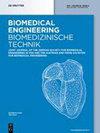采用三维有限元分析比较全on-4治疗概念中不同假体材料和后路种植体角度的生物力学差异
IF 1.8
4区 医学
Q4 ENGINEERING, BIOMEDICAL
引用次数: 0
摘要
摘要本研究旨在通过三维有限元分析评估All-on-4种植体固定义齿不同材料和种植体后牙角度的生物力学行为。使用Rhinoceros和VRMesh Studio程序创建完整的无牙上颌骨模型。采用All-on-4设计定位前侧垂直种植体和后侧17°和30°角度种植体。使用3D扫描仪扫描直和角度多单元基台。模拟了两种不同的假体上部结构(单片氧化锆框架和二硅酸锂贴面(ZL)和单片氧化锆增强硅酸锂(ZLS))。根据假体结构和后种植体角度设计四种模型。后路垂直双侧负荷和正面斜向负荷。分析了主应力(骨组织- pmax和Pmin)和von Mises等效应力(种植体和假体结构)。在所有模型中,计算皮质骨后侧双侧载荷下的最大Pmax应力值。ZL-17和ZL-30模型在双侧后侧负荷(260.33 MPa和219.50 MPa)下,后侧种植体的von Mises应力水平最高。在两种载荷下,ZLS模型与ZL模型相比,假体结构的应力水平更高。种植体后角对种植体材料和牙槽骨组织的应力分布无显著差异。ZLS和ZL假体结构可可靠地用于上颌All-on-4修复。本文章由计算机程序翻译,如有差异,请以英文原文为准。
Biomechanical comparison of different prosthetic materials and posterior implant angles in all-on-4 treatment concept by three-dimensional finite element analysis
Abstract The study aimed to evaluate the biomechanical behaviors of different prosthetic materials and posterior implant angles in All-on-4 implant-supported fixed maxillary prostheses with three-dimensional (3D) finite element analysis. The model of complete edentulous maxilla was created using the Rhinoceros and VRMesh Studio programs. Anterior vertical and 17°- and 30°-angled posterior implants were positioned with All-on-4 design. Straigth and angled multi-unit abutments scanned using a 3D scanner. Two different prosthetic superstructures (monolithic zirconia framework and lithium disilicate veneer (ZL) and monolithic zirconia-reinforced lithium silicate (ZLS)) were modeled. Four models designed according to the prosthetic structure and posterior implant angles. Posterior vertical bilateral loading and frontal oblique loading was performed. The principal stresses (bone tissues-Pmax and Pmin) and von Mises equivalent stresses (implant and prosthetic structures) were analyzed. In all models, the highest Pmax stress values were calculated under posterior bilateral loading in cortical bone. The highest von Mises stress levels occured in the posterior implants under posterior bilateral load (260.33 and 219.50 MPa) in the ZL-17 and ZL-30 models, respectively. Under both loads, higher stress levels in prosthetic structures were shown in the ZLS models compared with ZL models. There was no difference between posterior implant angles on stress distribution occurred in implant material and alveolar bone tissue. ZLS and ZL prosthetic structures can be reliably used in maxillary All-on-4 rehabilitation.
求助全文
通过发布文献求助,成功后即可免费获取论文全文。
去求助
来源期刊
CiteScore
3.50
自引率
5.90%
发文量
58
审稿时长
2-3 weeks
期刊介绍:
Biomedical Engineering / Biomedizinische Technik (BMT) is a high-quality forum for the exchange of knowledge in the fields of biomedical engineering, medical information technology and biotechnology/bioengineering. As an established journal with a tradition of more than 60 years, BMT addresses engineers, natural scientists, and clinicians working in research, industry, or clinical practice.

 求助内容:
求助内容: 应助结果提醒方式:
应助结果提醒方式:


